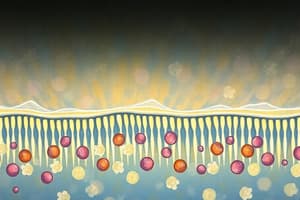Podcast
Questions and Answers
Which statement best describes diffusion?
Which statement best describes diffusion?
- Movement of particles across a cell membrane without the use of energy. (correct)
- Diffusion is only relevant for waste products, not nutrients.
- Movement of particles across a cell membrane requiring energy.
- Movement of molecules from low concentration to high concentration.
What is the main difference between passive transport and active transport?
What is the main difference between passive transport and active transport?
- Passive transport moves particles from low to high concentration, while active transport moves particles from high to low concentration.
- Passive transport is faster than active transport.
- Active transport only involves diffusion, while passive transport involves osmosis.
- Active transport requires the cell to use energy, while passive transport does not. (correct)
What process is responsible for moving nutrients into a cell by utilizing protein channels?
What process is responsible for moving nutrients into a cell by utilizing protein channels?
- Diffusion (correct)
- Osmosis
- Exocytosis
- Endocytosis
In what scenario would active transport be necessary?
In what scenario would active transport be necessary?
Which process involves the cell taking in large particles not suitable for protein channels?
Which process involves the cell taking in large particles not suitable for protein channels?
What happens during exocytosis?
What happens during exocytosis?




